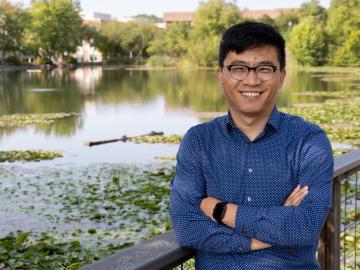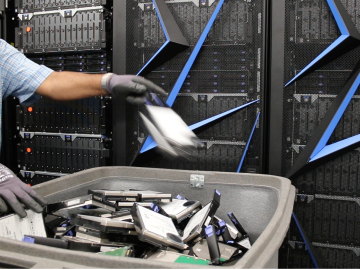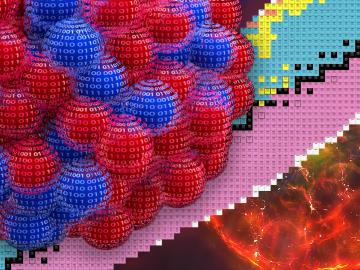Filter News
Area of Research
- (-) Biology and Environment (180)
- (-) Supercomputing (318)
- Advanced Manufacturing (34)
- Biological Systems (18)
- Biology and Soft Matter (5)
- Building Technologies (12)
- Chemical and Engineering Materials (4)
- Chemistry and Physics at Interfaces (11)
- Computational Biology (6)
- Computational Chemistry (5)
- Computational Engineering (5)
- Computer Science (19)
- Data (1)
- Electricity and Smart Grid (3)
- Energy Frontier Research Centers (14)
- Energy Science (525)
- Energy Sciences (5)
- Fossil Energy (3)
- Fuel Cycle Science and Technology (3)
- Functional Materials for Energy (16)
- Fusion and Fission (55)
- Fusion Energy (19)
- Geographic Information Science and Technology (3)
- Isotope Development and Production (3)
- Isotopes (36)
- Materials (434)
- Materials Characterization (2)
- Materials for Computing (36)
- Materials Synthesis from Atoms to Systems (13)
- Materials Under Extremes (12)
- Mathematics (1)
- National Security (81)
- Neutron Data Analysis and Visualization (4)
- Neutron Science (212)
- Nuclear Science and Technology (75)
- Nuclear Systems Modeling, Simulation and Validation (3)
- Nuclear Systems Technology (1)
- Quantum Condensed Matter (4)
- Quantum information Science (9)
- Reactor Technology (1)
- Sensors and Controls (5)
- Transportation Systems (11)
News Type
News Topics
- 3-D Printing/Advanced Manufacturing (13)
- Advanced Reactors (2)
- Artificial Intelligence (41)
- Big Data (29)
- Bioenergy (50)
- Biology (76)
- Biomedical (28)
- Biotechnology (15)
- Buildings (6)
- Chemical Sciences (15)
- Clean Water (11)
- Composites (5)
- Computer Science (105)
- Coronavirus (22)
- Critical Materials (4)
- Cybersecurity (9)
- Energy Storage (11)
- Environment (105)
- Exascale Computing (28)
- Frontier (32)
- Fusion (2)
- Grid (7)
- High-Performance Computing (56)
- Hydropower (8)
- Isotopes (3)
- Machine Learning (20)
- Materials (24)
- Materials Science (22)
- Mathematics (5)
- Mercury (7)
- Microscopy (16)
- Molten Salt (1)
- Nanotechnology (16)
- National Security (9)
- Neutron Science (16)
- Nuclear Energy (5)
- Partnerships (6)
- Physics (9)
- Polymers (4)
- Quantum Computing (20)
- Quantum Science (24)
- Security (6)
- Simulation (26)
- Software (1)
- Space Exploration (3)
- Summit (47)
- Transportation (8)
Media Contacts

The National Center for Computational Sciences, located at the Department of Energy’s Oak Ridge National Laboratory, made a strong showing at computing conferences this fall. Staff from across the center participated in numerous workshops and invited speaking engagements.

This year’s Association for Computing Machinery’s Gordon Bell Prize in supercomputing goes to researchers led by the University of Melbourne who used the Frontier supercomputer to conduct a quantum molecular dynamics simulation 1,000 times greater in size and speed than any previous simulation of its kind.


In early November, researchers at the Department of Energy’s Argonne National Laboratory used the fastest supercomputer on the planet to run the largest astrophysical simulation of the universe ever conducted. The achievement was made using the Frontier supercomputer at Oak Ridge National Laboratory.

Using a best-of-nature approach developed by researchers working with the Center for Bioenergy Innovation at the Department of Energy’s Oak Ridge National Laboratory and Dartmouth University, startup company Terragia Biofuel is targeting commercial biofuels production that relies on renewable plant waste and consumes less energy. The technology can help meet the demand for billions of gallons of clean liquid fuels needed to reduce emissions from airplanes, ships and long-haul trucks.

ORNL has been recognized in the 21st edition of the HPCwire Readers’ and Editors’ Choice Awards, presented at the 2024 International Conference for High Performance Computing, Networking, Storage and Analysis in Atlanta, Georgia.
Researchers led by Oak Ridge National Laboratory have been criss-crossing the Alaskan tundra for 12 years, collecting data as part of the Next-Generation Ecosystem Experiments in the Arctic project, or NGEE Arctic. They’re tracking rapid changes in the land as temperatures rise.

Daryl Yang is coupling his science and engineering expertise to devise new ways to measure significant changes going on in the Arctic, a region that’s warming nearly four times faster than other parts of the planet. The remote sensing technologies and modeling tools he develops and leverages for the Next-Generation Ecosystem Experiments in the Arctic project, or NGEE Arctic, help improve models of the ecosystem to better inform decision-making as the landscape changes.

The Summit supercomputer, once the world’s most powerful, is set to be decommissioned by the end of 2024 to make way for the next-generation supercomputer. Over the summer, crews began dismantling Summit’s Alpine storage system, shredding over 40,000 hard drives with the help of ShredPro Secure, a local East Tennessee business. This partnership not only reduced costs and sped up the process but also established a more efficient and secure method for decommissioning large-scale computing systems in the future.

Nuclear physicists at the Department of Energy’s Oak Ridge National Laboratory recently used Frontier, the world’s most powerful supercomputer, to calculate the magnetic properties of calcium-48’s atomic nucleus.


